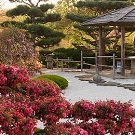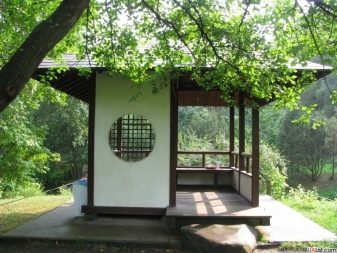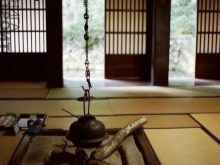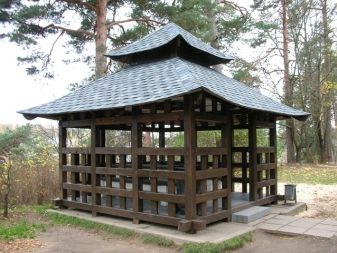Japanese-style Gazebo: Oriental Design Features

Summer provides an excellent opportunity for outdoor recreation. At the cottage in our gazebo, being among the beautiful flowers and greenery, all problems and bad thoughts are forgotten, and we plunge into the wonderful scent of our garden.
Harmony with nature
In our country, a person gets oneness with nature and spiritual harmony at his country site. While at work, he is looking forward to the end of everyday work in order to leave the city rush and be alone with himself, with his family and close friends.
Nowadays, the fascination with Oriental style has become very popular. The fact that this style has become to many liking confirms its presence in the interiors of our apartments, the design of lawns, avenues, and buildings.
The Japanese-style pergolas that have fallen in love bribe everyone with their elegance and simplicity, reflecting the outlook and the refined taste of their owners.
Special features
The Japanese are very wise to the construction of arbors - they take into account the directions of the cardinal points. The southern side is provided for solid walls so that bright sunshine does not penetrate, and there is coolness. The western and eastern side - with windows, for relaxation during sunrise or sunset, but the entrance to the arbor is usually made from the north side. If you foresee the construction on stilts, then the whole structure will look weightless and hovering above the ground.
Arbor requires a special approach to the choice of place on a country site. It should be positioned so that it can be viewed almost the entire suburban area.
Near the building there may be a small pond or an unusual fountain. At the entrance there will be a spectacular oriental style curved bridge with elegant steps and a small artificial stream under it. The presence of water is a must - it helps to calm and relax.
The shape of the roof creates the effect of lightness and airiness of the whole construction of the arbor. It fits into several tiers - this is a special Japanese philosophy, reflecting the peace and tranquility of the human soul. The roof stands out for its spectacularity; it looks more complicated and luxuriant with the outward simplicity of the building itself. The corners of the roof are trying to lift to give the effect of a floating, airy construction.
At home, the traditional building materials for the gazebo are bamboo, cane and oiled rice paper, and straw is used for roofing. In our climatic conditions for the construction of taken exclusively natural materials - wood or stone. When using artificial materials, the individuality of the building and the feeling of harmony with nature are lost.
Around the gazebo plant those plants that are particularly fond of the Japanese. - they prefer camellias, chrysanthemums, peonies, irises. Of the trees, special priority is given to larch and fruit trees. The companion of any eastern construction will always be the beloved Sakura.
Outside the Japanese house in the corners of the roof and under the walls are placed outdoor decorations - Japanese garden lights, which provide lighting.
Design features
The construction of the arbor itself is distinguished by its diversity, it can have the form:
- fans,
- hexagon or octahedron,
- round or square.
The size of the gazebo should pay special attention, since it is strictly regulated by the Japanese. In the Japanese house, the floors are completely covered with mats - tatami, which are used in quantities of no more than 4-6 pieces. The size of the tatami is historically unchanged and is only 190 cm by 90 cm. In order for the penetrating light to illuminate the guests sitting on the floor, the windows are placed at the bottom of the gazebo.
The sun's rays must necessarily fall into the gazebo, for this is done another row of windows, which are placed under the eaves. The number of windows in the gazebo should not be less than 6-8 pieces - this is a regulation. Windows set round or oval. They are effectively decorated with bamboo lattices.
For tea ceremonies in Japan, there are special arbors, Tysitsu. They differ from others in that their entrance is very low: only by bending can you get inside.
Interior decoration
The presence of curtains is one of the hallmarks of gazebos that have come to us from the East.In the openings have pots with flowers. If a vine is grown nearby, it will serve as a natural curtain. Inside the arbor is equipped with a niche for compositions of flowers or painting. In the center of the Japanese house set the oven for making tea.
Bright colors are not involved in the design - pastel colors are characteristic of the Japanese arbor. Asceticism and minimalism - these are the basic rules of the Japanese style. In the interior of the gazebo there are small chairs and a table made of wood or stone. The Japanese love restraint, because in the interior of the arbor everything should be very simple, without eye-catching rich details.
Do-it-yourself gazebo construction
Buildings in the Japanese style will make any country site unusual and stylish. Having decided to bring an oriental style, it is necessary to think out everything clearly and build an arbor so that it fits into the overall composition of the site and looks harmonious with the surrounding buildings. If there is a small elevation on the site, then this will be the most successful place for construction.
In the construction of their own hands should provide a simple option - a round or square arbor. Before construction, you must draw a drawing to clearly represent the future design. Construction begins with the marking of the territory. The angles and diagonals of the rectangle are measured.
The light wooden construction of the future gazebo will not require a particularly deep base. The easiest way to install a column foundation. In order for the gazebo to visually soar above the ground, it is necessary to dig poles in the corners, having previously dug up meter pits. The bottom of each pillar is saturated with hot bitumen. After installing the pillars, the pits are filled with cement-gravel mortar.
Install the lower trim of the beam, fixed intermediate beams, which will give the desired rigidity. Lags are installed on the strapping and intermediate beam.
On special metal supporting elements, logs are fixed on which the flooring of flooring boards is laid. Knowingly for ventilation and rainwater runoff, gaps between the boards are provided. Next, secure the top trim of the building. That's all, the arbor frame is ready.
The roof should be wider than the pergola itself, slightly concave, and, as in a temple in the East, have curved edges and a pointed edge upward.Wood does not withstand weather changes in our climate, so it should be treated with antiseptics. When painting are used only acrylic paints.
Self-knowledge through communication with nature
In order to be in harmony with oneself, it is necessary to look for points of contact with nature. The perception of the world in Japanese culture is expressed in the sense of beauty and the desire to admire and sometimes worship and deify every natural phenomenon. Japanese gardens are a special philosophy of life of the Japanese. In the gardens of the owner invested his soul.
The tea drinking procedure in Japan is a special cult., combining elements of both architecture and painting, and landscape art. The tea ceremony embodies the unity of perception of the surrounding nature, creativity, philosophical mood and communication. In Japan, the ritual of the tea ceremony for centuries takes place in small houses, which are located in shady gardens far from the existing bustle of the surrounding life.
A modern man, having a country plot, finds in it a unity with nature.
By giving the site a Japanese style, he will be able to get a little in touch with the principles of Japanese philosophy:
- the principle of harmony bears in itself the concept of the unity of man with nature;
- the principle of respect reflects equality and respect for each other;
- the principle of purity is the purification of the human soul through the knowledge of the beautiful.
To get to know yourself and the world around you, you don’t need to do so much - just put a small Japanese house and a gazebo in your area and style it in the eastern fashion for tea ceremonies and a great time in communicating with loved ones. Around the gazebo, it is necessary to provide an island of nature with an amazing bridge and a stream or a small fountain, as well as to equip garden paths that will decorate the landscape of the site. Blooming flowers and climbing plants, planted with the hands of the owner, will remind you of the coloring of Japan.
In the next video you will find a review of a pretty Japanese-style gazebo.
































































